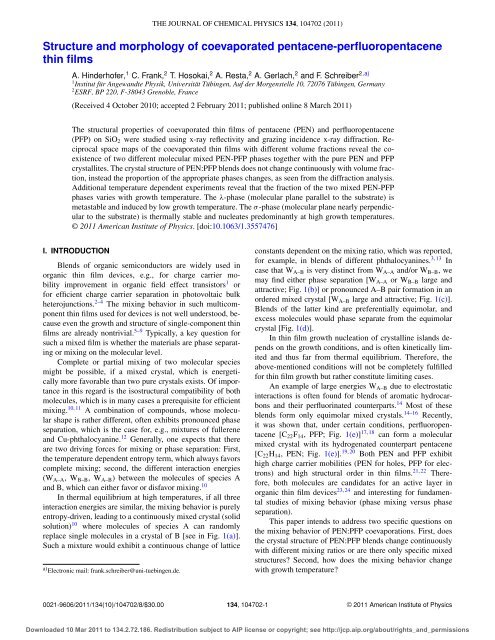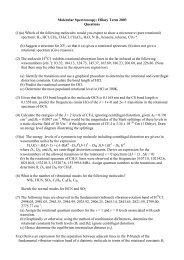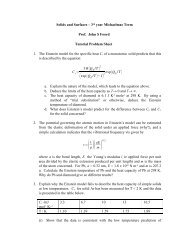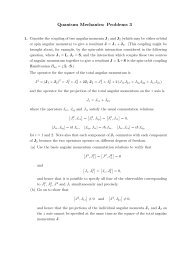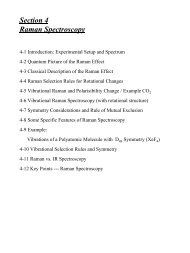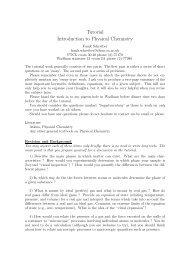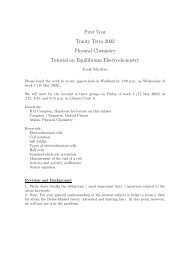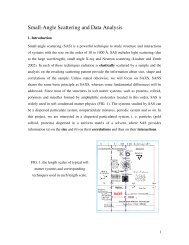the journal of chemical physics 134, 104702 - Institut für ...
the journal of chemical physics 134, 104702 - Institut für ...
the journal of chemical physics 134, 104702 - Institut für ...
You also want an ePaper? Increase the reach of your titles
YUMPU automatically turns print PDFs into web optimized ePapers that Google loves.
<strong>104702</strong>-7 Blends <strong>of</strong> pentacene and perfluoropentacene J. Chem. Phys. <strong>134</strong>, <strong>104702</strong> (2011)FIG. 7. (a) Simulated electron density pr<strong>of</strong>iles <strong>of</strong> a thin film with two differentcrystal structures. The inset shows a sketch <strong>of</strong> <strong>the</strong> sample structure.(b) Simulated XRR data from <strong>the</strong> electron densities shown in (a). The insetshows <strong>the</strong> dependence <strong>of</strong> <strong>the</strong> lattice spacing on <strong>the</strong> parameter d.FIG. 8. (a) Simulated electron density pr<strong>of</strong>iles <strong>of</strong> two films with a differentlattice spacing l s and <strong>the</strong> electron density if <strong>the</strong>se structures are mixed. Forclarity <strong>the</strong> electron density <strong>of</strong> <strong>the</strong> mixture is shifted. (b) Simulated XRR datafrom <strong>the</strong> electron densities shown in (a). The inset shows a sketch <strong>of</strong> <strong>the</strong>mixed film with two lattice spacings.density <strong>of</strong> ρ 1 = 0.53 Å −3 —four layers <strong>of</strong> a second materialwith l s = 15.8 Å and ρ 2 = 0.425 Å −3 . An important parameteris <strong>the</strong> normalized distance (1 s + d) between <strong>the</strong> first and<strong>the</strong> second material. In Fig. 7(a) electron density pr<strong>of</strong>iles areshown with different d = {−1; 0; 1} Å, where for d = 0<strong>the</strong> distance between <strong>the</strong> first and <strong>the</strong> second material is equalto <strong>the</strong> distance between two layers <strong>of</strong> a single material.The Bragg peak positions in <strong>the</strong> corresponding reflectivitycurves [Fig. 7(b)] are clearly shifted with respect to eacho<strong>the</strong>r. The inset shows <strong>the</strong> dependence <strong>of</strong> <strong>the</strong> deduced apparentlattice spacing on <strong>the</strong> parameter d. This simulationshows that <strong>the</strong> Bragg peak positions in this case depend approximatelylinearly on d. The shift has a magnitude similarto <strong>the</strong> shift we observed for <strong>the</strong> nonequimolar PEN:PFP mixturespresented in Fig. 4(b).2. XRR simulations with in-plane phase separationIn <strong>the</strong> case <strong>of</strong> lateral phase separation, we assume that<strong>the</strong> two crystal structures are growing on <strong>the</strong> substrate nextto each o<strong>the</strong>r [inset in Fig. 8(b)]. For <strong>the</strong> simulation we assumethat <strong>the</strong> two structures have <strong>the</strong> same electron densityρ = 0.35 Å −3 but different lattice spacings with l s1 = 15.4Åand l s2 = 16 Å. The resulting electron density for a film wi<strong>the</strong>ight layers <strong>of</strong> <strong>the</strong> two structures and <strong>the</strong> mixture are shownin Fig. 8(a). The resulting XRR curves [Fig. 8(b)] show that<strong>the</strong> Bragg peak maximum <strong>of</strong> <strong>the</strong> mixture would correspondto different lattice spacings dependent on diffraction order.For <strong>the</strong> second and third diffraction order, <strong>the</strong> Bragg peakmaximum is at a lower q z compared to both single crystalstructures.These two simulations illustrate that without exactknowledge <strong>of</strong> <strong>the</strong> microscopic spatial arrangement <strong>of</strong> <strong>the</strong>crystal structures in a phase-separated thin film Bragg peakpositions in XRR cannot unambiguously be converted into alattice plane spacing.1 K. Walzer, B. Maennig, M. Pfeiffer, and K. Leo, Chem. Rev. 107, 1233(2007).2 P. Peumans, S. Uchida, and S. R. Forrest, Nature (London) 425, 158(2003).3 A. Opitz, B. Ecker, J. Wagner, A. Hinderh<strong>of</strong>er, F. Schreiber, J. Manara,J. Pflaum, and W. Brütting, Org. Electron. 10, 1259 (2009).4 J. Wagner, M. Gruber, A. Hinderh<strong>of</strong>er, A. Wilke, B. Bröker, J. Frisch, P.Amsalem, A. Vollmer, A. Opitz, N. Koch, F. Schreiber, and W Brütting,Adv. Funct. Mater. 20, 4295 (2010).5 F. Schreiber, Phys. Status Solidi A 201, 1037 (2004).6 G. Witte and C. Wöll, J. Mater. Res. 19, 1889 (2004).7 S. Kowarik, A. Gerlach, and F. Schreiber, J. Phys. Condens. Matter 20,184005 (2008).Downloaded 10 Mar 2011 to <strong>134</strong>.2.72.186. Redistribution subject to AIP license or copyright; see http://jcp.aip.org/about/rights_and_permissions
<strong>104702</strong>-8 Hinderh<strong>of</strong>er et al. J. Chem. Phys. <strong>134</strong>, <strong>104702</strong> (2011)8 B. Krause, F. Schreiber, H. Dosch, A. Pimpinelli, and O. Seeck, Europhys.Lett. 65, 372 (2004).9 A. C. Dürr, N. Koch, M. Kelsch, A. Rühm, J. Ghijsen, R. L. Johnson, J.-J.Pireaux, J. Schwartz, F. Schreiber, H. Dosch, and A. Kahn, Phys.Rev.B68, 115428 (2003).10 A. I. Kitaigorodsky, Mixed Crystals (Springer, Berlin, 1984).11 J.-O. Vogel, I. Salzmann, S. Duhm, M. Oehzelt, J. P. Rabe, and N. Koch,J. Mater. Chem. 20, 4055 (2010).12 A. Opitz, J. Wagner, W. Brütting, A. Hinderh<strong>of</strong>er, and F. Schreiber, Phys.Status Solidi A 206, 2683 (2009).13 E. A. Lucia and F. D. Verderame, J. Chem. Phys. 48, 2674 (1968).14 E. A. Meyer, R. K. Castellano, and F. Diederich, Angew. Chem., Int. Ed.42, 1210 (2003).15 S. Bacchi, M. Benaglia, F. Cozzi, F. Demartin, G. Filippini, and A. Gavezzotti,Chem.-Eur. J. 12, 3538 (2006).16 F. Ponzini, R. Zagha, K. Hardcastle, and J. S. Siegel, Angew. Chem., Int.Ed. 39, 2323 (2000).17 Y. Sakamoto, T. Suzuki, M. Kobayashi, Y. Gao, Y. Fukai, Y. Inoue, F. Sato,and S. Tokito, J. Am. Chem. Soc. 126, 8138 (2004).18 A. Hinderh<strong>of</strong>er, U. Heinemeyer, A. Gerlach, S. Kowarik, R. M. J. Jacobs,Y. Sakamoto, T. Suzuki, and F. Schreiber, J. Chem. Phys. 127, 194705(2007).19 I. Salzmann, S. Duhm, G. Heimel, J. P. Rabe, N. Koch, M. Oehzelt, Y.Sakamoto, and T. Suzuki, Langmuir 24, 7294 (2008).20 S. Kowarik, K. Broch, A. Hinderh<strong>of</strong>er, A. Schwartzberg, J. O. Osso, D. Kilcoyne,F. Schreiber, and S. R. Leone, J. Chem. Phys. 114, 13061 (2010).21 S. Kowarik, A. Gerlach, A. Hinderh<strong>of</strong>er, S. Milita, F. Borgatti, F. Zontone,T. Suzuki, F. Biscarini, and F. Schreiber, Phys. Status Solidi (RRL) 2, 120(2008).22 S. Schiefer, M. Huth, A. Dobrinevski, and B. Nickel, J. Am. Chem. Soc.129, 10316 (2007).23 Y. Inoue, Y. Sakamoto, T. Suzuki, M. Kobayashi, Y. Gao, and S. Tokito,Jpn. J. Appl. Phys. 44, 3663 (2005).24 T. Yokoyama, C. B. Park, T. Nishimura, K. Kita, and A. Toriumi,Jpn. J. Appl. Phys. 47, 3643 (2008).25 K. A. Ritley, B. Krause, F. Schreiber, and H. Dosch, Rev. Sci. Instr. 72,1453 (2001).26 N. Andrew, J. Appl. Crystallogr. 39, 273 (2006).27 M. Birkholz, Thin Film Analysis by X-Ray Scattering (Wiley, Weinheim,2006).28 S. Kowarik, A. Gerlach, S. Sellner, F. Schreiber, L. Cavalcanti, andO. Konovalov, Phys. Rev. Lett. 96, 125504 (2006).29 A.-L. Barabasi and H. E. Stanley, Fractal Concepts in Surface Growth(Cambridge University Press, Cambridge, 1995).30 A. C. Dürr, F. Schreiber, K. A. Ritley, V. Kruppa, J. Krug, H. Dosch, andB. Struth, Phys. Rev. Lett. 90, 016104 (2003).31 I. Salzmann, S. Duhm, G. Heimel, M. Oehzelt, R. Kniprath, R. L. Johnson,J. P. Rabe, and N. Koch, J. Am. Chem. Soc. 130, 12870 (2008).Downloaded 10 Mar 2011 to <strong>134</strong>.2.72.186. Redistribution subject to AIP license or copyright; see http://jcp.aip.org/about/rights_and_permissions


